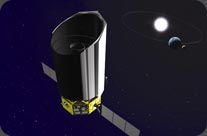|
 |
 |
 |
 |
 |
|


I belong to two Akari research groups. One is for galaxy cluster observation. The aim of the study is to understand the formation and mechanism of galaxies. Galaxies are grouped into high-density galaxy clusters and field galaxies. By comparing these galaxies and clusters, you can see how they influence each other. The other research group is studying supernova remnants - the remains of supernova explosions. The inside of the remnants is a very hot gas, which gradually cools off. The group's objective is to understand this process and clarify the mechanism of the death of a star. Supernova remnants have not yet been studied in the infrared, so we are greatly looking forward to seeing what Akari will be able to show us.
|
|
|
|
|


In other scientific fields, there has been a lot of collaboration between Japan and Korea, but in the world of astronomy we had been a little behind. Most Korean astronomers have studied in the United States, so there has been a tendency to collaborate with people in that country. But the U.S. is very far away and Japan is very close. We may not have known about each other before, but the Akari project has brought us much closer together, and the collaboration between our two countries is growing rapidly. X-ray scientists are also now working on collaborating with Japan. People who work on optical observation are interested in using the Subaru telescope. Japan would like Korean astronomers to get involved in the development of observation instruments. And in the field of radio astronomical observation, a bridge between the Korea Astronomy and Space Science Institute and the National Astronomical Observatory of Japan was built after Akari. I think Akari has been the pioneer of collaborative astronomical research between our two countries.
At present, I am leading an infrared astronomy study group in Korea. Inspired by the Akari collaboration, we have been discussing many different infrared astronomy projects. Our hope is to develop our own infrared micro-satellite in the near future. It will be very small compared to Akari, but in infrared astronomy there are some areas where very small satellites become useful. There are plans for science and technology satellites in Korea, and we are now proposing to launch an infrared observatory on one of them. Many Korean satellites are micro-satellites; they have been launched with other devices, as piggyback payloads. We have launched four micro-satellites in total, using Russian, Iranian and Indian rockets, and several large multipurpose or commercial satellites, via U.S. launch vehicles. Although there is a possibility that we will use a Japanese rocket to launch a large communication or meteorological satellite in the future, we would like to use a Korean experimental rocket for the launch of the next infrared observation micro-satellite, which is currently in the planning stages.
Also, we are proposing to our government that we should participate in Japan's next project, SPICA, the Space Infrared Telescope for Cosmology and Astrophysics. We would like to get involved on a different level next time, such as providing observation instruments rather than just processing data.
|
|


The proposed next-generation Japanese infrared space telescope SPICA
|
|
 |
 |
 |
Hyung Mok Lee
Professor, Seoul National University
Korean Representative to the Akari (ASTRO-F) International Collaborative Research Group
Dr. Lee specializes in infrared astronomy. After finishing graduate school at Seoul National University, he earned a Ph.D. in Astrophysics at Princeton University in the United States. During his time there, his interest grew in infrared astronomy. Fascinated with the world's first infrared astronomical satellite, IRAS, launched in 1983, he worked at IPAC (the Infrared Processing and Analysis Center) at Caltech, where the IRAS data was being processed. Later he was a Visiting Research Physicist at the University of California, Santa Barbara, before being appointed Associate Professor at Pusan National University. Subsequently, Dr. Lee became a Professor at Seoul National University. He is scheduled to stay on the Sagamihara Campus, JAXA/ISAS from February to July 2006. |
|
|
 |

 
|
|



